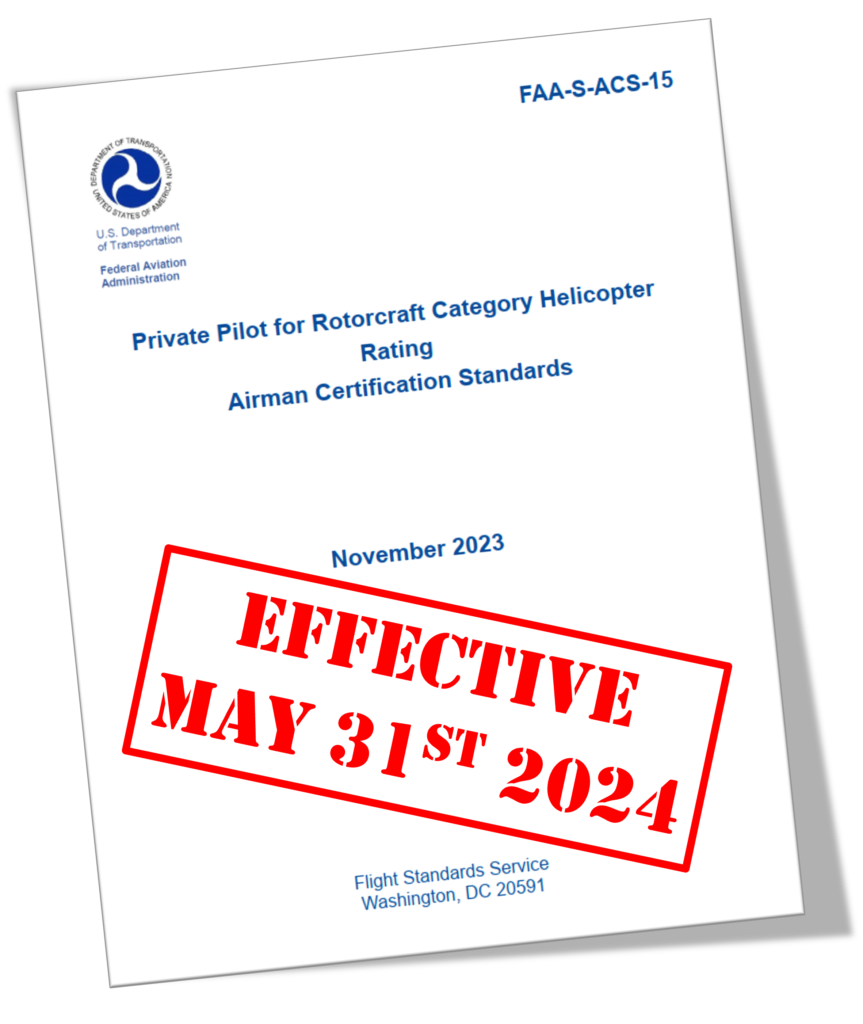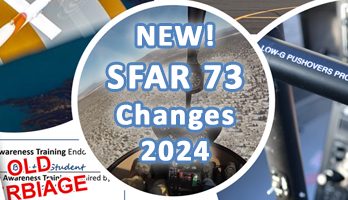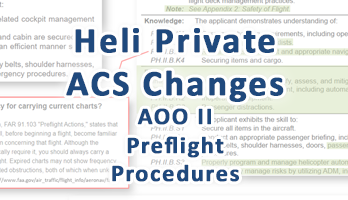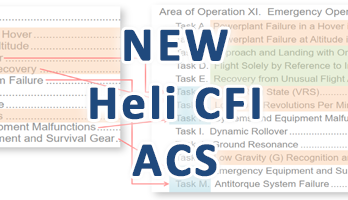Effective May 31st, 2024 the FAA Helicopter Private PTS (along with Commercial, Instrument & CFI) will be replaced by the new FAA Helicopter Private Pilot ACS (Airman Certification Standards).
Before taking the knowledge test or practical exam (checkride) you should be looking through every element in every applicable task and ask yourself “Am I confident about this?” And if the answer is “No“, use your instructor and the task references to help you learn/practice what the FAA wants you to know, consider & do to pass the exams. Below are just some of the key differences from the PTS for each task in the new Helicopter Private Pilot ACS , I. Preflight Preparation Area of Operation (AOO).
- General ACS Changes
- Follow Along
- Helicopter ACS Private Pilot Part 1, The BIG Changes Video
- Preflight Preparation Renamed Tasks
- Task A – Pilot Qualifications
- Task B – Airworthiness Requirements
- Task C – Weather Information
- Task D – Cross-Country Flight Planning
- Task E – National Airspace System
- Task F – Performance & Limitations
- Task G – Operation of Systems
- Task H – Human Factors
- More Info
- Feedback
General ACS Changes
But first, if the ACS is completely new to you, before reading the specific changes below check out our ACS overview article and ACS overview video covering the new ACS code system, task structure, required elements, changes to special emphasis areas, risk management and more.
Follow Along
If you want to follow along with the changes, grab the free PDF from the FAA’s ACS webpage or purchase the paper version (Amazon affiliate links used on this webpage to help support HTV) below. Paper versions also come with the ACS Companion Guide for Pilots (FAA-G-ACS-2).
Helicopter ACS Private Pilot Part 1, The BIG Changes Video
Also, if you haven’t already you might want to check out our Helicopter ACS Private Pilot Part 1 (The Big Changes) article and Part 1 video covering the big content changes, along with the Task rename & reorder updates for all the areas of operation in the Helicopter Private Pilot ACS.
Preflight Preparation Renamed Tasks
Task A is renamed from Certificate and Documents to Pilot Qualifications because the task items that related to the aircraft certificates and documents were moved into Task B (Airworthiness Requirements) and Task A became pilot-focused. See more information on Task A and Task B below.
Task H was renamed Human Factors from Aeromedical Factors, but the content area is mostly the same, see full details on Task H below.
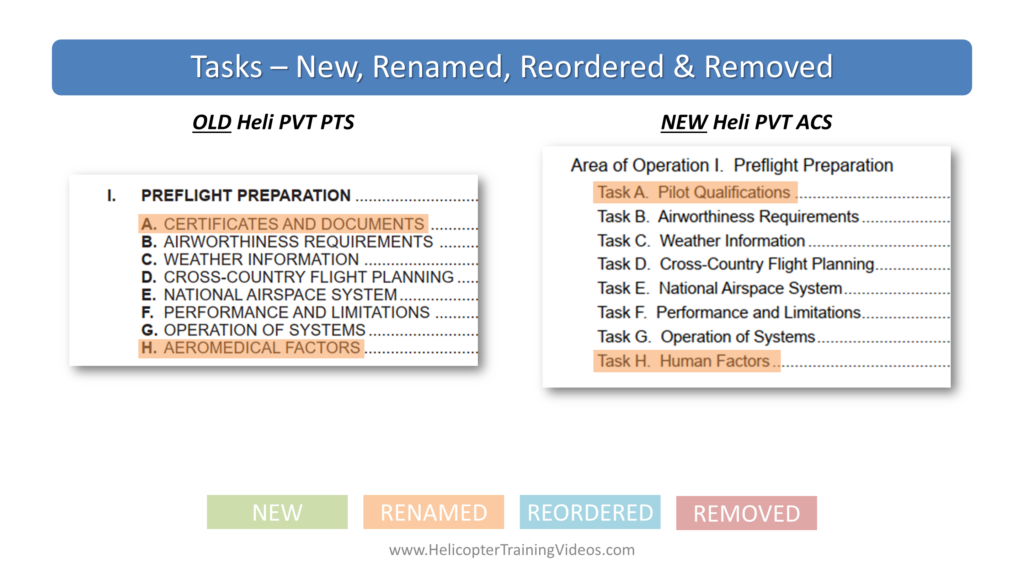
Task A – Pilot Qualifications
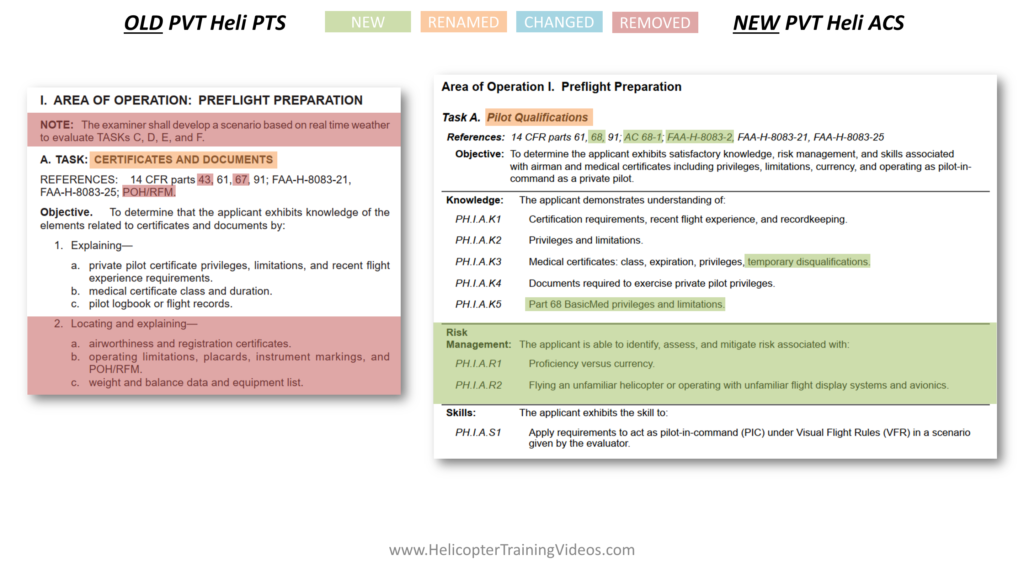
As already mentioned, Task A was renamed from Certificates and Documents to Pilot Qualifications, because the PTS section on aircraft airworthiness was moved from Task A into Task B. Because of that change, the references related to the aircraft were removed (Part 43 & the POH/RFM) but also Part 67, which seems odd as it relates to pilot medical certificates.
The note regarding the examiner using a scenario for Tasks C, D, E & F was removed, but this is largely irrelevant as in the ACS the examiner will be using scenarios as much as possible throughout the entire checkride anyway.
References
New references were add to Part 68 and the AC 68-1 which covers BasicMed. Also, due to the new Risk Management section of ACS tasks, all tasks will now have a reference to the FAA Risk Management Handbook 8083-2.
Knowledge
The knowledge section is mostly similar, but new elements include, temporary disqualifications to medical certificates and Part 69 (BasicMed) privileges & limitations.
Risk Management
In the new Risk Management section, consider scenarios that might pose risks associated with flight proficiency versus currency and flying an unfamiliar helicopter or unfamiliar instruments and avionics. For example, you become a private helicopter pilot, and you learned to fly in an R22 helicopter. Someone asks you to fly their new Cabri G2…Can you legally? Are there some risks involved? What are they and how could you mitigate them?
Task B – Airworthiness Requirements
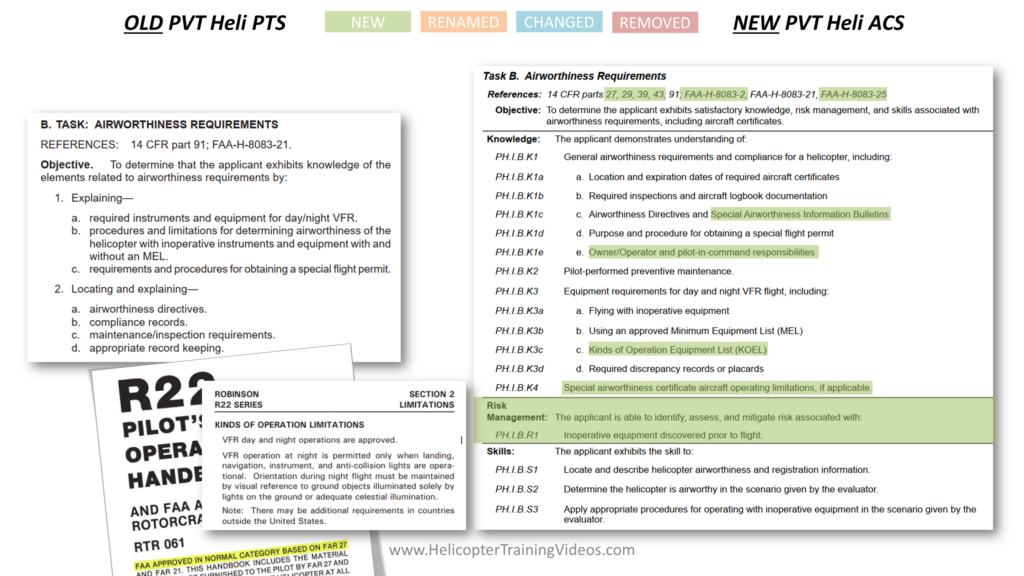
References
New references were added, including Part 27 and Part 29 which cover airworthiness requirements for normal and transport category helicopters and Part 39 which covers Airworthiness Directives (ADs). These three references are not in the paper FAR/AIM book, but can be found online. Part 43 covers preventative maintenance and there is also the FAA Risk Management Handbook 8083-2. Missing from both the PTS and the ACS list of task references are the aircraft POH/RFM (to cover Kinds of Operation Equipment List knowledge element) and AC-91-67 (cancelled but no good preplacement IMO) to explain how to deal with inoperative equipment and MELs.
Knowledge
New elements include Special Airworthiness Information Bulletins (SAIBs) like this SAIB for Robinson helicopter spindle bearing issues and an element on owner/operator versus PIC responsibilities for airworthiness. There is also elements on Kinds of Operation Equipment Lists (KOEL) and Special Airworthiness Certificate aircraft operating limitations (Light Sport, Experimental and Special Flight Permits).
Risk Management
The risk management section has only a single element, meaning you will have no choice but to cover this element on the checkride(learn what are the ACS minimum requirements in this General ACS Changes video). The element covers the risk management of finding inoperative equipment prior to flight (use the flowchart in AC-91-67).
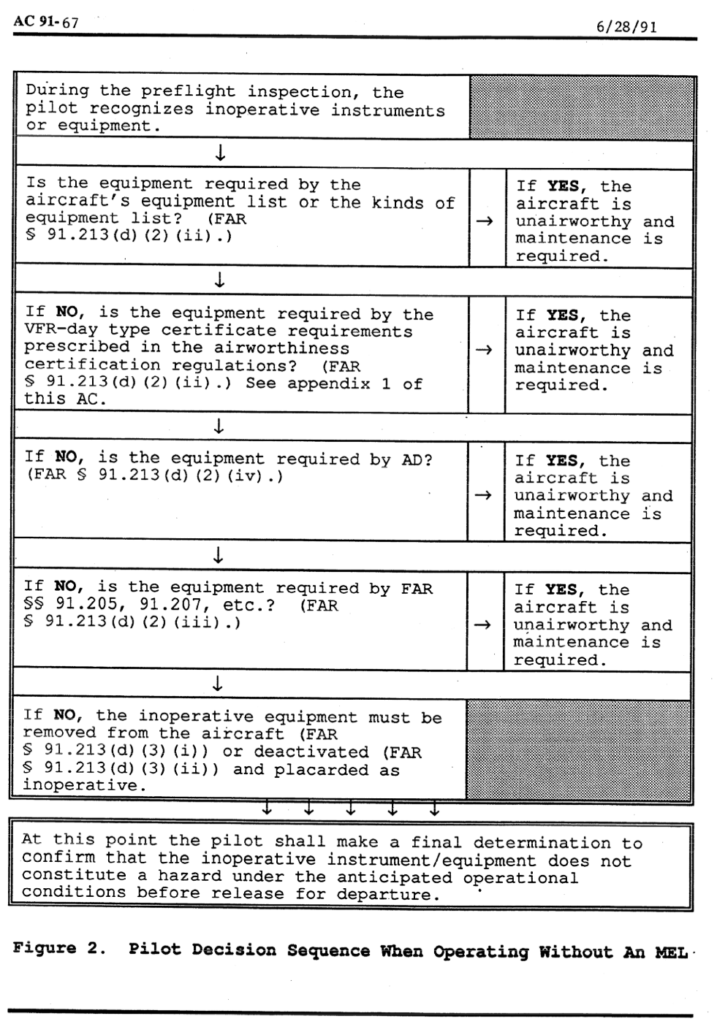
Task C – Weather Information
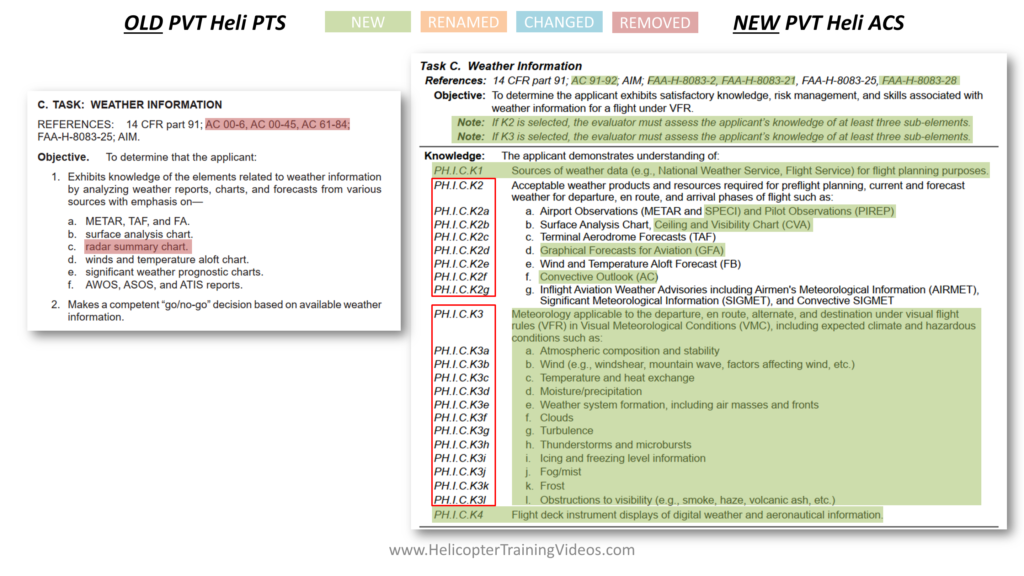
References
The ACS removed the old cancelled weather ACs on Aviation Weather, Weather Services and the role of preflight. In their place was added the new Aviation Weather Handbook, AC 91-92 Pilot Guide to Preflight Briefing the usual Risk Management Handbook and Helicopter Flying Handbook. Also look at the PHAK Chapters 12 & 13.
Knowledge
Element K1 covers sources of weather – AWC, FSS, 1800-wx-brief (calling or website), ForeFlight etc. If you use ForeFlight, expect questions on where ForeFlight get it’s weather and is it valid for preflight planning (NOAA and yes – see AC 91-92).
If element K2 or K3 selected, a minimum of 3 sub elements must be covered. Those include some products not found in the PTS like SPECIs, PIREPs, CVA chart, GFA and Convective Outlook.
K3 new sub elements imply the ability to explain things such as temperature & heat exchange, details of microbursts, types of fog & how they form.
K4 requires an understanding of flight deck weather if you have it. So if you have ADS-B weather, know how it works, how to use it and when/how it updates.
Lastly it seems weather radar product is no longer listed.
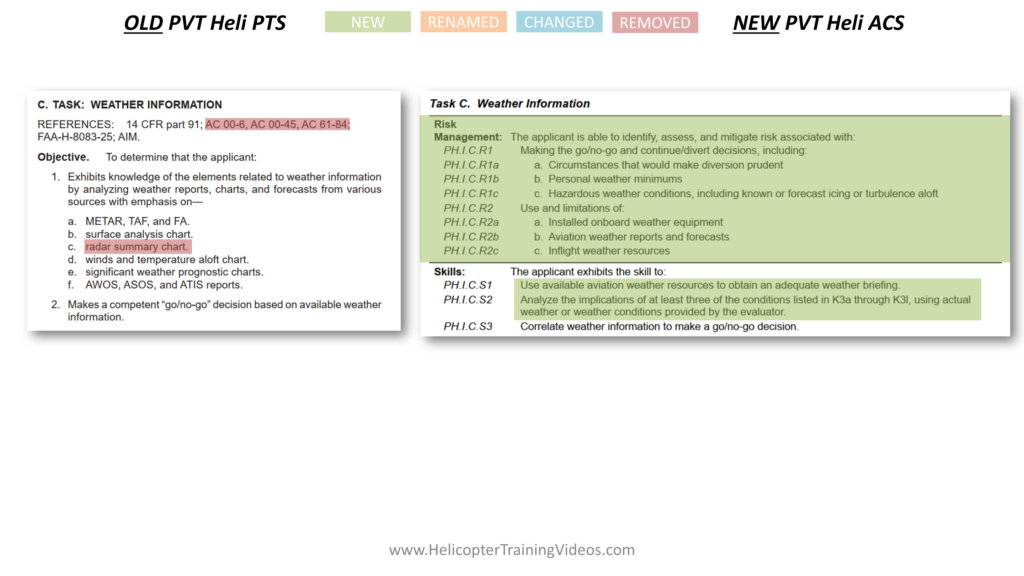
Risk Management
Lots of new risk management specific elements, including circumstances that might cause diversion (weather, fuel, passenger issues, etc.) Also, have personal minimums already written down (day/night, local & XC). Under forecast hazards it includes known icing conditions – what is known icing conditions? There has been some confusion on that over the years, check out this HTV article on Known Icing Conditions.

Skills
Obtain an adequate weather briefing (I like calling 1800-Wx-Brief) but you could use the 1800 website, AWC, or ForeFlight, etc. Also analyze impact of at least 3 using actual weather or weather provided by the evaluator’s scenario. And like in the PTS, make a Go/No Go decision.
Task D – Cross-Country Flight Planning
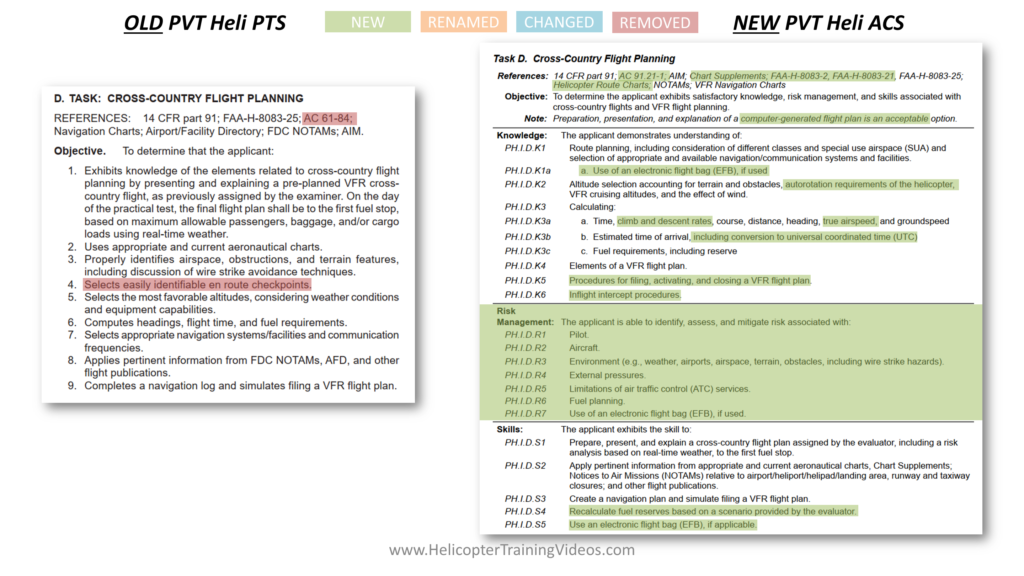
References
The ACS removed reference to the cancelled AC 61-84 (Role of Preflight Prep) and added the Helicopter Flying Handbook, Risk Management Handbook, AC 91-21-1 (Use of Portable Electronics on a/c) and Helicopter Route Charts. It also renamed renamed the old A/FD to the updated Chart Supplement. Check out PHAK Ch16 for navigation guidance.
Note
Computer generated flight plan is acceptable, but you must still know the process to go from true course to a compass heading, etc. We still recommend you start training with paper nav log & an E6B to fully understand where something like ForeFlight gets the numbers from.
Knowledge
Some of knowledge areas were probably covered in a PTS checkride, but now they are explicitly listed. Also notice use of EFB is a knowledge element, so if you use something like ForeFlight expect questions like “Are you allowed to use that in an aircraft? How do you know?” )Hint it is in the referenced AC 91-21-1. Also “How does ForeFlight get it’s nav log numbers?“
Under altitude selection, the ACS wants you to consider helicopter autorotation performance in selecting a cruise altitude. For example it is best to be higher if over inhospitable terrain and/or with tail wind. The ACS also now talks of specifically knowing climb/descent rates & calculating TAS (rule of thumb + 2% per 1000’) as well as converting times to to UTC (Zulu time). There is also elements concerning how to file, activate and close a VFR flight plan. Some options include FSS radio, telephone (1800-wx-brief), text (via the 1800 website), & using a EFB like ForeFlight. Lastly, you can expect possible questions regarding an intercept procedures scenario.
Risk Management
You can expect scenario-based questions to assess your risk management in the 4 risk areas – Pilot, Aircraft, Environment and External pressures (PAVE) as well as the limitations of ATC services (radio & radar coverage at helicopter altitudes) and EFB risks (battery, overheat, etc.)
Skills
You still need to prepare and present an assigned cross-country using real-time weather and NOTAMs to first fuel stop. You will still need to prepare a nav log, but now also perform a risk analysis. You also still need to simulate filing VFR flight plan, but now also have to deal with a scenario causing change to the flight plan, requiring a fuel reserve recalculation (practice this).
Once again there is mention of EFB (if used) as an assessed element. And strangely no mention in the ACS of enroute checkpoints being ‘easily identifiable‘ – maybe that is just too obvious to be mentioned? Or maybe more emphasis now placed on GPS usage and position overlayed on an EFB map?
Task E – National Airspace System
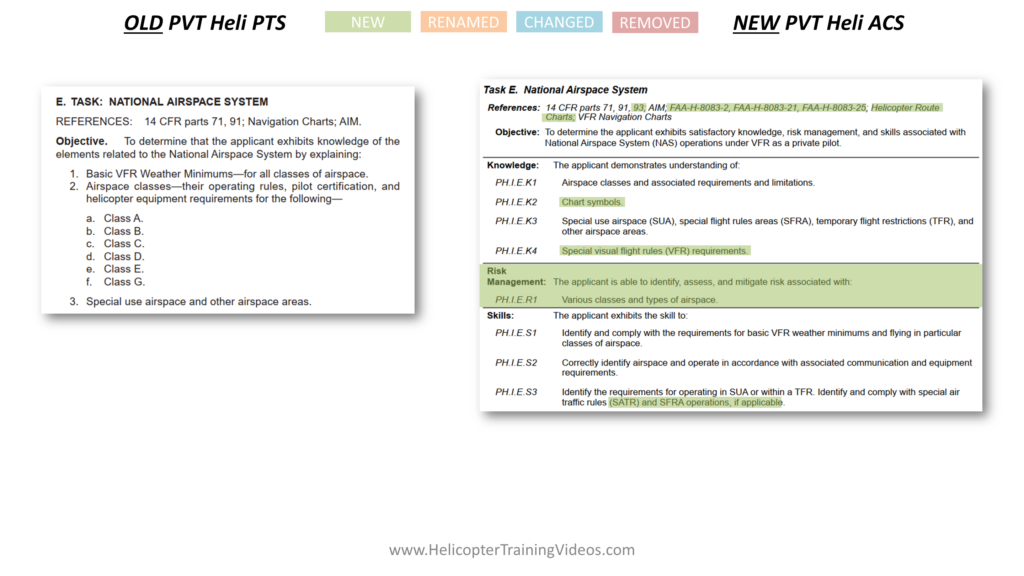
References
ACS still has Part 71 (Airspace Designations) which is in the in FAR/AIM book. But the ACS also has some new references: Part 93 (Special Air Traffic Rules – not in paper FAR/AIM), Helicopter Route Charts (find on ForeFlight or SkyVector) and the usual Helicopter Flying Handbook and Risk Management Handbook. Also check out the PHAK Chapter 15 on airspace. One reference this is missing from both PTS and ACS is the incredibly useful Aeronautical Chart Users’ Guide.
Knowledge
The ACS specifically calls for identification of chart symbols, which is why I highly recommend the FAA’s Aeronautical Chart Users’ Guide. It also wants you to know all about Special VFR – when you need it, how to get it, any limitations, etc.
Risk Management
For the ACS, with all it’s specific elements, this seems vague with no specifics strangely.
Skills
Very similar to the PTS, but with mention of SATR (Special Air Traffic Rules) & SFRA (Special Flight Rule Area) covered in Part 93.
Task F – Performance & Limitations
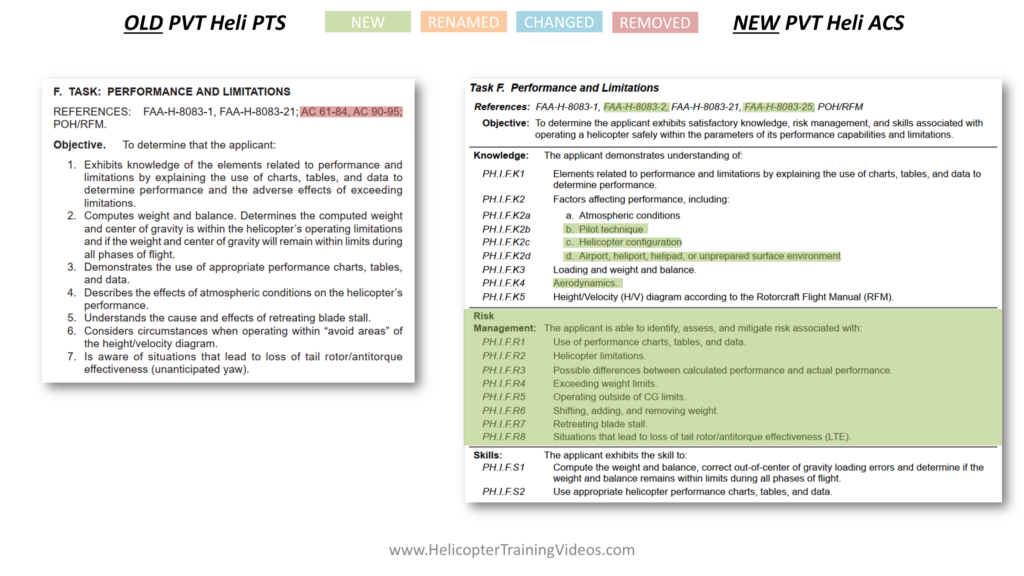
References
From the PTS, the ACS removed the old (& cancelled) AC 61-84 (role of preflight), but also strangely removed AC 90-95 (Unanticipated Yaw ). AC 90-95 has not been cancelled and is a great resource for unanticipated yaw (LTE) and LTE is specifically mentioned in the Risk Management section, so I believe it was removed in error.
The ACS added the usual Helicopter Flying Handbook (check out chapters 6 & 7) and Risk Management Handbook. Also check out part of the PHAK Chapter 11 before it gets too airplane specific. Another good reference is the FAA’s Aircraft Weight & Balance Handbook.
If you are using a Robinson helicopter for your checkride, check out SN-37 Exceeding Operating Limits, SN-42 Unanticipated Yaw & SN-25 Carb Ice (when to pull extra 1.5, etc.) if applicable.
You can also check out the HTV article on the Height-Velocity Diagram.
Knowledge
The ACS added pilot technique, configuration and landing surface as elements to consider when thinking about aircraft performance. It also specifically mentions aerodynamics related to performance and limitations (think IGE/OGE, Retreating Blade Stall and LTE).
Risk Management
The new Risk Management section covers much of PTS content, but also talks about the difference between paper performance and actual performance (add a margin, do OGE hover power checks, etc.) It also mentions shifting, adding & removing weight – so practice talking through those sort of scenarios (unexpected extra weight etc.)
Skills
There are no real changes from the PTS here.
Task G – Operation of Systems
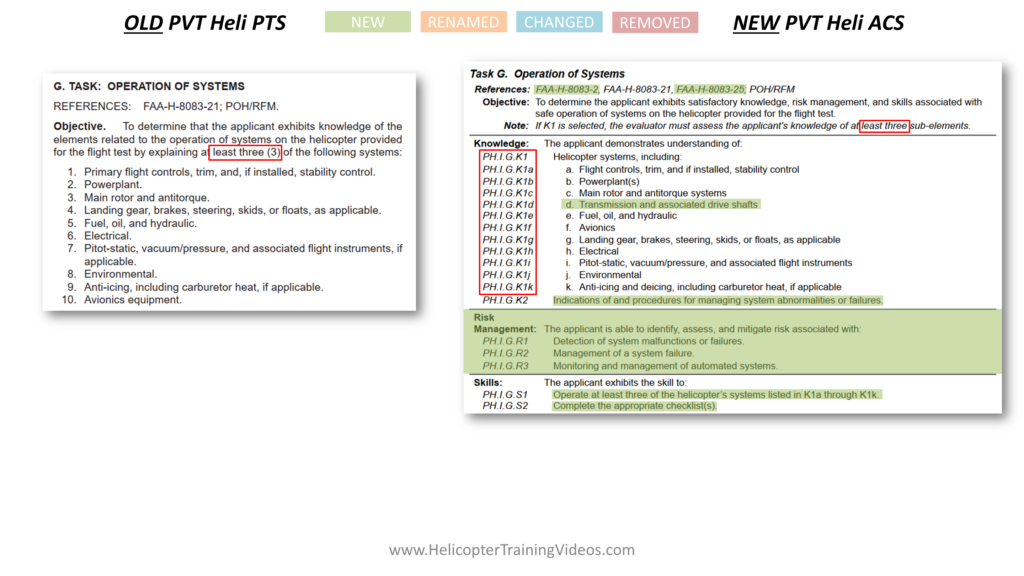
References
The ACS added the usual Helicopter Flying Handbook (check out chapters 3, 4 & 11) and Risk Management Handbook.
Also check out sections 3 (Emergency Procedures) and 7 (Systems) of your aircraft POH/RFM.
Knowledge
Much of the content is similar to the PTS, but the ACS added transmission & drive shafts (how does engine power get to main & tail rotors?). Element K2 requires the applicant to not only know the systems, but also be able to know the indications and procedures for managing system abnormalities or failures (in other words, know your EPs!)
Risk Management
This section really covers dealing with malfunctions and making good decisions (Land and Live) in scenario-based questions.
Skills
The skill element requires the applicant to operate at least 3 systems, which will usually be completed just by starting the helicopter (engine, fuel, oil, transmission, flight controls, etc.) As discussed in the General ACS Changes video, the ACS now disperses special emphasis items throughout ACS into the related tasks – so here we have a checklist usage element.
Task H – Human Factors
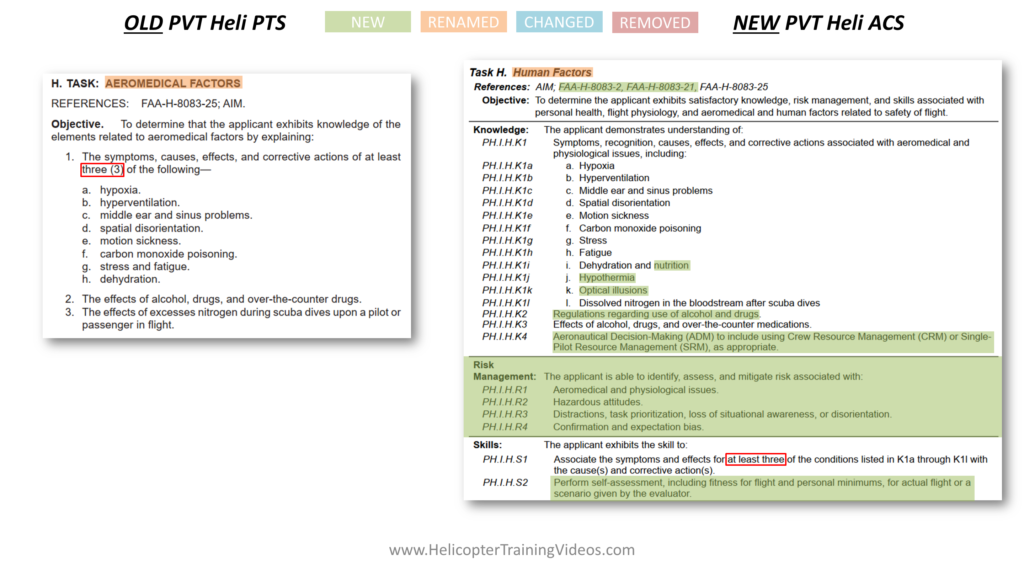
Task H was renamed from Aeromedical Factors to Human Factors, but much of the ACS content is similar to the PTS.
References
The ACS added the usual Helicopter Flying Handbook (check out chapter 13) and Risk Management Handbook. The PHAK has most of this covered in Chapter 2 and Chapter 17.
Knowledge
Much of the content is similar to the PTS, but with the addition of nutrition, hypothermia & optical illusions. For all the sub elements of K1, make sure you know the causes, symptoms, effects & corrective actions. The ACS also specifically added an element on the regulations regarding alcohol & drugs. And K4 is a dedicated element covering ADM/CRM/SRM (check out the PHAK Chapter 2, HFH Chapter 13 and much of the Risk Management Handbook).
Risk Management
The Risk Management section covers a few areas, including hazardous attitude & antidotes (use IM AIR memory aid) as well as distractions and situational awareness (previous PTS special emphasis areas). A new element not used in the PTS is confirmation and expectation bias – check out the Risk Management Handbook for more information on those terms.
Skills
In a scenario given by the evaluator (or the checkride flight), the applicant will make a self assessment – use the IMSAFE memory aid and have personal minimums already written down!
More Info
The next article/video will dig deep in to AOO II. Preflight Procedures, covering every task and show the specific element changes. Until then, to learn more about the changes from Helicopter PTS to ACS and some of the references mentioned in this article, check out the following:
- Helicopter ACS General Changes Video
- Helicopter ACS Private Pilot, Part 1 – Big Changes Video
- Helicopter ACS Playlist (Full Details for PVT, COM, INST & CFI Changes)
- FAA Airmen Certification Standards
- HTV Known Icing Conditions Article
- AC 90-95 (Unanticipated Right Yaw in Helicopters)
- AC 68-1 (BasicMed)
- AC 91-67 (MEL & INOP Equipment)
- AC 91-92 (Preflight Briefing)
- AC 91-21-1 (Use of PED)
- Robinson Safety Notices
- FAA SAIBs
- Aeronautical Chart Users’ Guide
If you want to purchase the paper versions below are Amazon affiliate links that help support HTV. Paper versions also come with the ACS Companion Guide for Pilots (FAA-G-ACS-2).
DISCLAIMER – make sure you are fully informed on the latest regulations and their application.
For official guidance on laws and regulations, refer to your Certified Flight Instructor (CFI) or local Flight Standards District Office (FSDO) . Helicopter Training Videos aims to promote aviation knowledge and safety but makes no guarantees regarding accuracy or legal applications.
Feedback
What changes to the Helicopter Private Pilot ACS have you seen? Let us know using the comments form below:




